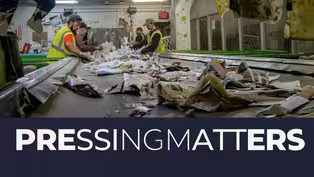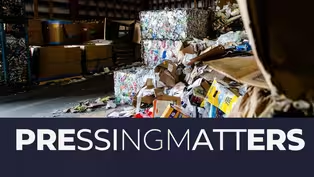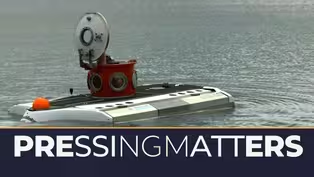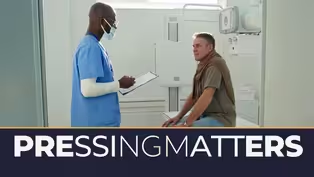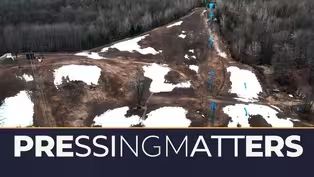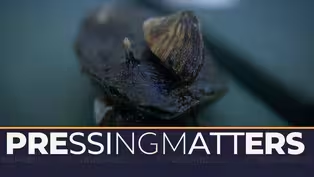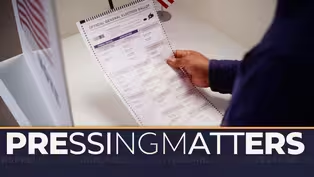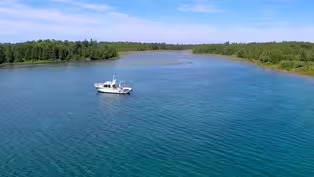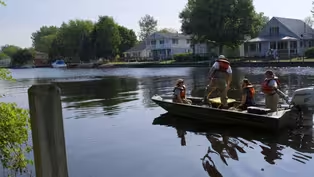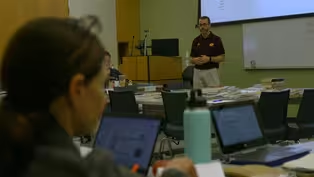Pressing Matters
Pressing Matters | A New Era of Exploring the Great Lakes
Clip: Season 1 | 7m 58sVideo has Closed Captions
Pressing Matters Examines A New Era of Exploring the Great Lakes
Pressing Matters Examines A New Era of Exploring the Great Lakes
Problems playing video? | Closed Captioning Feedback
Problems playing video? | Closed Captioning Feedback
Pressing Matters is a local public television program presented by WCMU
Pressing Matters
Pressing Matters | A New Era of Exploring the Great Lakes
Clip: Season 1 | 7m 58sVideo has Closed Captions
Pressing Matters Examines A New Era of Exploring the Great Lakes
Problems playing video? | Closed Captioning Feedback
How to Watch Pressing Matters
Pressing Matters is available to stream on pbs.org and the free PBS App, available on iPhone, Apple TV, Android TV, Android smartphones, Amazon Fire TV, Amazon Fire Tablet, Roku, Samsung Smart TV, and Vizio.
Providing Support for PBS.org
Learn Moreabout PBS online sponsorshipA new era of exploring the Great Lakes is here.
Take a look at the latest addition to CMU's fleet to better protect our precious resource.
The submersible arrived on the campus of Central Michigan University and will eventually make its way to CMU's biological research station on Beaver Island.
Now, the journey for the sub to Mount Pleasant began in summer 2023 when two private submersible owners made a trip to the island.
Their visit took scientists to the very bottom of Lake Michigan, where researchers were stunned to find how vast the issue of invasive species is.
Here's more about that visit and discovery.
This story begins with a flight through the clouds and then takes a dive to the rocky bottom of Lake Michigan.
- It was interesting.
It was fun though.
It was exciting.
Well, I scuba dive.
I actually, I scuba dived.
But this is so different, you know, I didn't think it would be that different from the scuba diving, but it's incredibly different.
- Professor and director of CMU's biological station on Beaver Island Don Uzarski has experienced many different ways of exploring our Great Lakes, but his latest endeavor inside a submarine had him in awe.
And he's not the only one.
- When I'm driving down the road, the cars will slow down, they'll hang out the window and take pictures, and they'll come in front and they'll come in back and they'll go around until they've saturated and then they take off.
And so maybe in any of a long trip, you know, I'll have maybe 40 cars that will do that.
- [Stefanie] Understandably submersibles have a way of drawing a crowd.
Recently, a couple of private submarine owners brought their custom-made designs to the Emerald is while a visit made many beam with excitement, their purpose on the island wasn't just for play.
- Where we like to link up with universities for a week or so and dive where we provide the submarine at our costs.
We look at it as a vacation where the university gets an opportunity to have researchers, faculty have eyes on the bottom.
So it's a, an opportunity for them to get, get into a sub and see an environment that they haven't seen before.
- So we have two objectives with these subs here.
And one of them is to pair with what we're doing on the Emerald Isle, the ferry that services Beaver Island from Charlevoix.
Well, that water's being collected from the sea chest of the Emerald Isle, which puts it at about just under two meters of depth.
And what we don't have is any data that compare with that from the bottom, because Lake Michigan stratifies into specific layers due to temperature density differences.
So the bottom chemistry and biology is very different from the top.
And we never had those bottom data on the M.V.
Chippewa.
We can send equipment down and bring it back up, but that's in one location.
The other objective that we have, we were contacted by the DNR, Michigan DNR, and they're interested in spawning habitat, potential spawning habitat for lake trout, cisco, and whitefish.
And they wanted, they had some specific areas that they wanted us to record and look to see if that is one, is it already good habitat or two, could it be restored?
- [Stefanie] Submersible builders, Alec Smyth and Cliff Redus, were eager to help CMU researchers get to work.
Alex is the founder of Innerspace Science, which connects privately owned submersibles with scientists studying ocean and water related content.
Because it's not commercial they charge nothing for this service.
- It's more fun actually to do something useful than it is just to go and shoot a YouTube video.
And so a group of us got got together and I set up a webpage, innerspacescience.org.
It's not a company, it's not, it's just a webpage that acts as a matchmaking service.
So if you are a professor or a researcher or anybody who thinks they could use a submersible, but you don't have one, you don't have a budget for one, we have submersibles that cost really little to run because we launched from boat ramps.
We're not hiring a ship, which is the big expensive item.
And we align our vacation days and our leisure recreational dives with the needs of somebody who could use it.
So for example, this is a beautiful place to come, spend a few days.
Clear water, everything is fantastic and it's much more rewarding to do something and take graduate students out and they get to see what they've been studying.
- This is a group of individuals that build these submarines for hobby purposes.
So we don't charge for hire, it's not a commercial business.
Yeah, we'll let folks take a ride in it if everything is okay but it's not a paid, we don't take people for pay, okay?
So strictly just a private thing.
- [Stefanie] With their mission in mind, the crew got work.
They launched Alec's two-person submarine into the water from the trailer.
After a lesson in how to steer and position themselves in the device it was time to head into open water, close the hatch, and sink.
Director Uzarski spent nearly two hours combing the underwater floor and taking water samples.
But what he saw with his eyes looking out of the portal window wasn't exactly what he was looking for or hoping for.
- We did not find the habitat we were looking for.
And I guess it was disappointing because really all I saw the entire time down there, I saw nuisance algae.
I saw invasive round gobies and I saw invasive zebra and quagga mussel.
And that was it for over an hour bottom time.
It was a perspective I've never had.
I've seen the bottom with our ROV, I've seen the bottom scuba diving.
But to see that distance of that same nuisance algae, zebra mussels, quagga mussels and round goby, all of that energy being tied up in nuisance algae and invasive species.
- [Stefanie] Now, because the submarines are designed by hobbyists, each one is a bit different.
In addition, with underwater research, the group with Innerspace Science visits schools as part of STEM-based projects mesmerizing young students.
But in northern Michigan, it was the adults who were learning about the subs' limitless possibilities.
- I think any aquatic research and any marine research could very much benefit from it because you can strap the equipment that you need onto this.
It has an arm.
So there are 4,000-year-old tree stumps out there, and I was controlling the arm to get a sample of that, to be able to carbonate it.
And there's just so much you could do with these things that it's unbelievable.
- And here once again, the very first shots of the submarine director Don Uzarski says they'll be using her for hands-on student development projects to enhance its capabilities before it's in use for research.
And when it's ready, Uzarski tells us they'll use it to monitor water quality and deaths over long distances, monitor habitat quality, and eventually use it to regularly inspect line five with special equipment that can detect cracks or faults in the underwater pipeline that are not visible to the naked eye.
Now the submarine is named Amik Dodem, meaning Beaver Clan.
The Saginaw Chippewa tribe named her knowing she would be birthed at Beaver Island.
Pressing Matters | What happens when the recyclables are picked up?
Video has Closed Captions
Clip: S1 | 9m 20s | Our knowledge about what happens to the items we recycle stops once we get it out of the house. (9m 20s)
Pressing Matters | Extended Producer Responsibility (EPR) what is it?
Video has Closed Captions
Clip: S1 | 12m 2s | We discuss Extended Producer Responsibility (12m 2s)
Pressing Matters | A New Era of Exploring the Great Lakes
Video has Closed Captions
Clip: S1 | 7m 58s | Pressing Matters Examines A New Era of Exploring the Great Lakes (7m 58s)
Pressing Matters | Rising Cancer Rates in younger Adults
Video has Closed Captions
Clip: S1 | 12m 1s | Pressing Matters examines Rising Cancer Rates in younger Adults (12m 1s)
Pressing Matter |Climate Change Forces Business to Adapt
Video has Closed Captions
Clip: S1 | 5m 56s | Pressing Matters examines how Climate Change Forces Business to Adapt (5m 56s)
Pressing Matters | Invasive species
Video has Closed Captions
Clip: S1 Ep4 | 8m 2s | Pressing Matters | They're Destructive and a nuisance. (8m 2s)
Pressing Matters | Election Day
Video has Closed Captions
Clip: S1 Ep4 | 15m 48s | What you need to know before heading to the polls, on Pressing Matters. (15m 48s)
Video has Closed Captions
Clip: S1 Ep1 | 8m 41s | Water Quality and PFAS in Michigan's water ways. (8m 41s)
Video has Closed Captions
Clip: S1 Ep1 | 9m 20s | Exploring microplastics in our water (9m 20s)
Artificial Intelligence in the Classroom
Video has Closed Captions
Clip: S1 Ep1 | 6m 55s | Artificial Intelligence in the Classroom (6m 55s)
Providing Support for PBS.org
Learn Moreabout PBS online sponsorship
- News and Public Affairs

Top journalists deliver compelling original analysis of the hour's headlines.

- News and Public Affairs

FRONTLINE is investigative journalism that questions, explains and changes our world.












Support for PBS provided by:
Pressing Matters is a local public television program presented by WCMU
